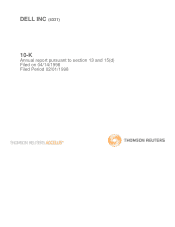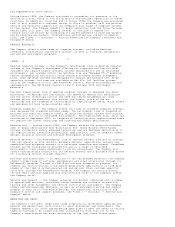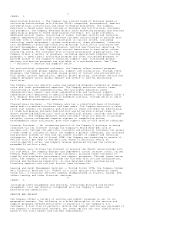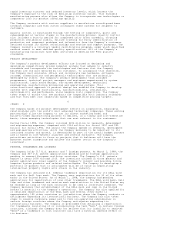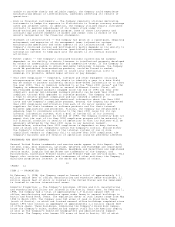Dell 1997 Annual Report Download - page 3
Download and view the complete annual report
Please find page 3 of the 1997 Dell annual report below. You can navigate through the pages in the report by either clicking on the pages listed below, or by using the keyword search tool below to find specific information within the annual report.The Company's business strategy, centered around its direct business model, is
customer-focused and aims to deliver the best customer experience through
direct, comprehensive customer relationships, cooperative research and
development with technology partners, custom-built computer systems and service
and support programs tailored to customer needs. The Company believes that this
approach provides it with several competitive advantages. The approach
eliminates the need to support an extensive network of wholesale and retail
dealers, thereby avoiding typical dealer mark-ups; avoids the higher inventory
costs associated with the wholesale/retail channel and the competition for
retail shelf space; and reduces the obsolescence risk associated with products
in a rapidly changing technological market. In addition, direct customer contact
allows the Company to maintain, monitor and update a database of information
about customers and their current and future products and service needs, which
can be used to shape future product offerings and post-sale service and support
programs. This direct approach, combined with the Company's efficient
procurement, manufacturing and distribution processes, allows the Company to
bring relevant technology to its customers faster and more competitively priced
than many of its competitors.
Comprehensive Customer Relationships -- The Company develops and utilizes direct
customer relationships to understand end-users' needs and to deliver high
quality computer products and services tailored to meet those needs. The type of
relationship depends on the type of customer. For large corporate and
institutional customers, the relationship may begin prior to sale, when the
Company works with the customer to plan a strategy to meet that customer's
current and future technology needs. The direct relationship continues after the
sale, as dedicated account teams consisting of sales, customer service and
technical personnel continue to support the customer's technology objectives.
The Company also establishes direct relationships with medium and small
businesses and home users, either through account representatives, through
telephone sales representatives or through Internet contact. All of these direct
customer relationships provide the Company with a flow of information about its
customers' plans and requirements and enable it to weigh their needs against
emerging technologies.
Cooperative Research and Development -- The Company also develops cooperative,
meaningful relationships with the world's most advanced technology companies.
Working with these compa-
<PAGE> 3
nies, the Company's engineers manage quality, integrate technologies and design
and manage system architecture. This cooperative approach allows the Company to
determine the best method and timing for delivering new technologies to the
market. The Company's goal is to deliver relevant technology to its customers at
the right time.
Custom-Built Computers -- The Company was founded on the principle that
delivering computers custom-built to specific customer orders is the best
business model for providing solutions that are truly relevant to end-user
needs. This build-to-order, flexible manufacturing process enables the Company
to achieve faster inventory turnover and reduced inventory levels and allows the
Company to rapidly incorporate new technologies and components into its product
offerings.
Custom-Tailored Service and Support Programs -- In the same way that the
Company's computer products are built-to-order, service and support programs are
designed to fit specific customer requirements. The Company offers a broad range
of service and support programs through its own technical personnel and its
direct management of specialized service suppliers. These services range from
telephone and Internet support to on-site customer-dedicated systems engineers.
While the Company believes that its business strategy provides it with
competitive advantages, there are many factors that may affect the Company's
business and the success of its operations. For a discussion of these factors,
see "Item 1 -- Business -- Factors Affecting the Company's Business and
Prospects" below.
GEOGRAPHIC AREAS OF OPERATIONS
The Company's products are currently sold in more than 170 countries worldwide.
The Company has organized its worldwide operations into geographic regions to
support its customers in each area through regional business units. The Americas
region, which is based in Round Rock, Texas, covers the United States, Canada
and Latin America. The European region, which is based in Bracknell, England,
covers the European countries and also some countries in the Middle East and
Africa. The Asia-Pacific/Japan region covers the Far East, including Japan,
Australia and New Zealand, and is based in Hong Kong (for areas other than
Japan) and Kawasaki, Japan (for Japan).
The Company's corporate headquarters are located in Round Rock, Texas, and its
manufacturing facilities are located in Austin, Texas; Limerick, Ireland; and
Penang, Malaysia. See "Item 2 -- Properties" below.
For financial information about the results of the Company's operations by
geographic region for each of the last three fiscal years, see Note 11 of Notes
to Consolidated Financial Statements included in "Item 8 -- Financial Statements

